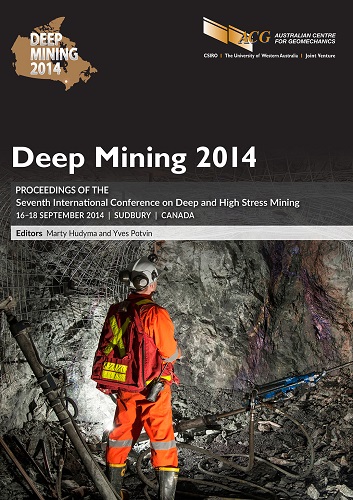Analysis and numerical modelling of dynamic ground support based on instrumented full-scale tests

|
Authors: Roth, A; Cala, M; Brändle, R; Rorem, E |
DOI https://doi.org/10.36487/ACG_rep/1410_08_Roth
Cite As:
Roth, A, Cala, M, Brändle, R & Rorem, E 2014, 'Analysis and numerical modelling of dynamic ground support based on instrumented full-scale tests', in M Hudyma & Y Potvin (eds), Deep Mining 2014: Proceedings of the Seventh International Conference on Deep and High Stress Mining, Australian Centre for Geomechanics, Perth, pp. 151-163, https://doi.org/10.36487/ACG_rep/1410_08_Roth
Abstract:
Ground support for dynamic conditions must be able to withstand the associated loads and deformations and the support scheme has to work as a system. In order to prove the suitability of such support systems with mesh and bolts, and to also analyse the bearing behaviour of them, a full scale test setup was commissioned in 2012 in Walenstadt, Switzerland. On this test rig it is possible to apply large energies on a ground support scheme with four dynamic bolts and a mesh panel of 2.4 × 2.4 m in a full-scale way. The test site is highly instrumented, and in this paper the analysis of the load cells, the accelerometers and the high speed video cameras is given. It can be shown that the bolts as the stiffest elements are always loaded first and then load is transferred to the surface support during the stopping process. Together with the numerical modelling and back calculation of the tests, it is possible to learn more about the stopping process of dynamic loading of ground support and consequently determine the load and energy distribution between the components. The full-scale tests show that stiff bolts and also mesh which is able to stop high loads at low deformations are required to withstand large dynamic loading without substantial deformations during a seismic event.
References:
Cala, M & Roth, A 2007, ‘Application of steel wire mesh for ground support under rockburst hazard’, Gornictwo i Geoinzynieria, vol. 31 b. 3/1, pp. 125-133 (in Polish).
Cala, M, Roth, A & Roduner, A 2013, ‘Large scale field tests of rock bolts and high-tensile steel wire mesh subjected to dynamic loading’, in M Kwasniewski & D Lydzba (eds), Proceedings of EUROCK 2013 – The 2013 ISRM International Symposium – Rock Mechanics for Resources, Energy and Environment, CRC Press, Boca Raton, pp. 721-726.
Hadjigeorgiou, J & Potvin, Y 2011, ‘A critical assessment of dynamic rock reinforcement and support testing facilities’, Rock Mechanics and Rock Engineering, vol. 44, pp. 565-578.
Heal, D 2010, ‘Observations and analyses of incidences of rock burst damage in underground mines’, PhD thesis, The University of Western Australia, Perth.
Heal, D, Hudyma, M & Potvin, Y 2004, ‘Assessing the in-situ performance of ground support systems subjected to dynamic loading’, Proceedings of the Fifth International Symposium on Ground Support in Mining and Underground Construction, E Villaescusa & Y Potvin (eds), Balkema, Rotterdam, pp. 319-326.
Kaiser, PK, Tannant, DD & McCreath, DR 1996, Canadian Rockburst Support Handbook, Geomechanics Research Centre, Sudbury.
Player, JR, Villaescusa, E & Thompson, AG 2004, ‘Dynamic testing of rock reinforcement using momentum transfer concept’, in E Villaescusa & Y Potvin (eds), Proceedings of the Fifth International Symposium on Ground Support in Mining and Underground Construction, Balkema, Rotterdam, pp. 327-339.
Potvin, Y 2012, ‘An interpretation of ground support capacity submitted to dynamic loading’, Australian Centre for Geomechanics Newsletter, vol. 39, pp. 1-5.
© Copyright 2026, Australian Centre for Geomechanics (ACG), The University of Western Australia. All rights reserved.
View copyright/legal information
Please direct any queries or error reports to repository-acg@uwa.edu.au
View copyright/legal information
Please direct any queries or error reports to repository-acg@uwa.edu.au